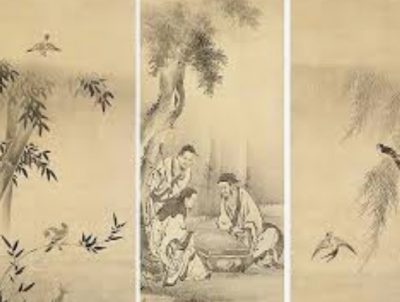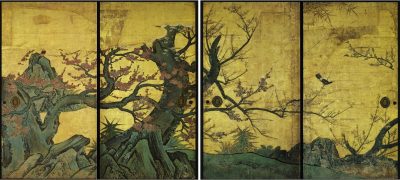Art of Japan and Sanraku: Pre-Edo period to early Edo and anti-Christianity
Lee Jay Walker
Modern Tokyo Times

Kano Sanraku (1559-1635) was a Japanese artist who lived during the pre-Edo era (Tokugawa Period) and the early Edo Period (1603-1868). Hence, bloodshed and issues with power concentration and regional dynamics were second nature for Sanraku.
Indeed, he witnessed the moderate policies that enabled Christianity to grow under Oda Nobunaga (1534-1582) to outright massacres against Christians under Tokugawa Iemitsu. Iemitsu’s violent tendencies from a young age emerged when he killed his homosexual lover. Therefore, Iemitsu’s rule (1623-1651) would virtually erase all traces of Christianity.
Sanraku was blessed to know the powerful warlord Toyotomi Hideyoshi (1537-1598). Henceforth, Hideyoshi supported the artwork of Sanraku and introduced him to the upper echelons of Japanese society. Hideyoshi also introduced anti-Christian policies that were a forerunner for Iemitsu during the early Edo Period.

In the field of art, Sanraku is deemed to be among the creme de la creme of Japanese screen painting artists that emerged during the Azuchi-Momoyama Period that ended in 1600. His mentor was Kano Eitoku (1543-1590), who produced art for Nobunaga and Hideyoshi. Therefore, the artistic links with Hideyoshi naturally developed for Sanraku.
Sanraku gained from the rich high culture of Kyoto and Nara. Likewise, the potent forces of Buddhism, Confucianism, and Shintoism were central religious and philosophical areas.
I reported in the past, “Another powerful patron of Sanraku was Tokugawa Hidetada, the second shogun of the Tokugawa period. In saying this, the power of Tokugawa Ieyasu remained until he died in 1616. Therefore, the powerful patrons of Sanraku highlight the rich cultural continuity of the pre-Tokugawa era and the unification period.”

Sanraku lived during a period of extreme power dynamics that ultimately led to the long-lasting Edo Period. He witnessed the religious enlightened approach under Nobunaga concerning Christianity – to mass persecution of the Christian faith that began under Hideyoshi and culminated with eradication under Iemitsu.
Emperor Ogimachi (1517-1593) introduced anti-Christian edicts before Hideyoshi. However, they had little effect during his reign (1557-1586). This concerns the power dynamics of Ogimachi’s period and the influence of Nobunaga, who was favorable towards the Christian faith.

Modern Tokyo News is part of the Modern Tokyo Times group
DONATIONS to SUPPORT MODERN TOKYO TIMES – please pay PayPal and DONATE to sawakoart@gmail.com
http://moderntokyotimes.com Modern Tokyo Times – International News and Japan News
http://sawakoart.com – Sawako Utsumi personal website and Modern Tokyo Times artist
https://moderntokyonews.com Modern Tokyo News – Tokyo News and International News
http://global-security-news.com Global Security News – Geopolitics and Terrorism
PLEASE JOIN ON TWITTER
https://twitter.com/MTT_News Modern Tokyo Times
PLEASE JOIN ON FACEBOOK
https://www.facebook.com/moderntokyotimes